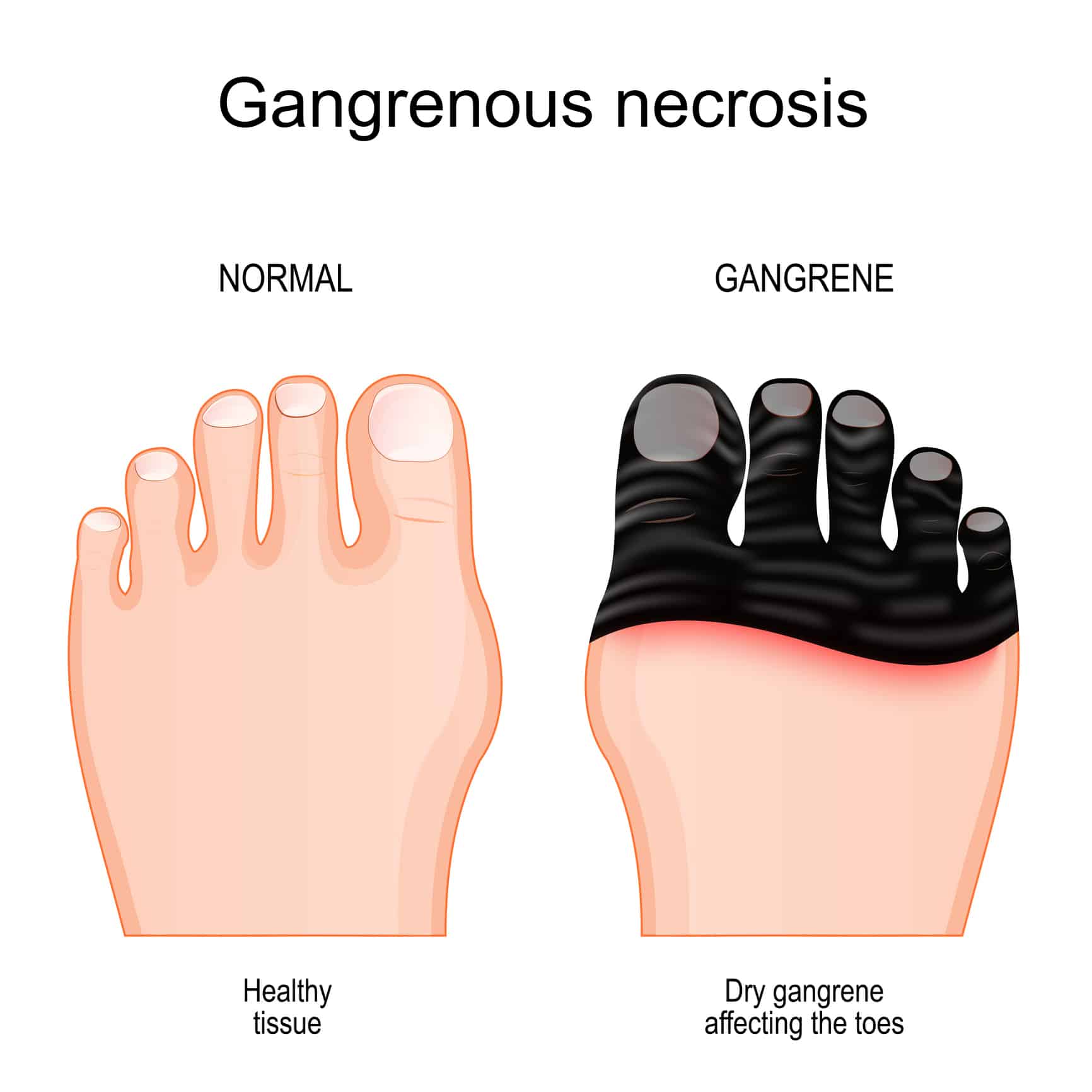Gangrene
Understanding Gangrene: A Comprehensive Overview
Gangrene is a serious and potentially life-threatening condition that occurs when a significant loss of blood supply leads to the death of body tissue. This condition can affect any area of the body but most commonly targets the extremities, such as toes, fingers, and limbs. Gangrene is often associated with underlying health issues, including diabetes, peripheral arterial disease, and infections, making early detection and treatment critical to preventing severe outcomes.
At the forefront of addressing this complex condition is Coastal Vascular Center, where our dedicated team, led by Dr. Ayar, specializes in diagnosing and treating vascular diseases that contribute to the development of gangrene. Dr. Ayar’s extensive experience and nuanced understanding of vascular health allow for personalized, compassionate care aimed at not only treating the symptoms but also addressing the underlying causes of gangrene.
As we delve into the intricacies of gangrene, including its types, causes, risk factors, and treatment options, it’s crucial to remember the importance of early intervention. If you or a loved one are experiencing symptoms that could indicate gangrene, such as unexplained pain, discoloration, or foul-smelling sores, contacting Dr. Ayar at Coastal Vascular Center can be a pivotal step in your healthcare journey. Together, we can work towards restoring your health and preventing the progression of this grave condition.
What is Gangrene?
Gangrene is a serious medical condition that occurs when a part of the body’s tissue dies, typically as a result of a loss of blood flow combined with infection. Blood circulation is essential for delivering oxygen and nutrients to tissues and removing waste products. When blood supply is significantly restricted or completely cut off, tissues can no longer sustain themselves and begin to deteriorate. While gangrene can affect any part of the body, it most commonly occurs in the extremities, such as fingers, toes, hands, legs, and feet. It may also affect internal organs in certain cases.
Gangrene is considered a medical emergency due to its potentially life-threatening complications, including the spread of infection and systemic toxicity. Immediate attention and prompt treatment are crucial to prevent further damage and preserve healthy tissue.
Types of Gangrene
Gangrene can present in various forms, each with distinct causes, symptoms, and characteristics:
Dry Gangrene
- Cause: Often results from reduced blood flow caused by underlying conditions such as peripheral arterial disease (PAD) or diabetes. It typically develops slowly and lacks infection initially.
- Appearance: Affected tissue is dry, shriveled, and discolored (ranging from brown to black).
- Key Feature: Less likely to cause infection but may progress to wet gangrene if left untreated.
Wet Gangrene
- Cause: Occurs when tissue dies and becomes infected due to injury or trauma. Wet gangrene develops quickly and is often associated with bacterial infections.
- Appearance: Swollen tissue that appears moist and discolored, emitting foul odors.
- Key Feature: Highly dangerous due to the risk of infection spreading systemically (sepsis).
Gas Gangrene (Clostridial Myonecrosis)
- Cause: Results from infection by Clostridium bacteria, which produce toxins and gas in the tissue. Often linked to deep wounds, surgical complications, or trauma.
- Appearance: Swollen tissue with gas bubbles under the skin; skin may feel crackly or spongy.
- Key Feature: Rapid progression and severe systemic toxicity.
Internal Gangrene
- Cause: Occurs when blood flow to internal organs (such as the intestines, appendix, or gallbladder) is blocked by conditions like hernias or blood clots.
- Symptoms: Severe pain, fever, nausea, and systemic signs of infection.
- Key Feature: Requires urgent surgical intervention due to the risk of organ failure.
Fournier’s Gangrene
- Cause: A rare but life-threatening form of gangrene affecting the genitals and surrounding areas. It is typically caused by infection and compromised blood supply.
- Key Feature: Often linked to underlying conditions such as diabetes or immunosuppression.
Get the Expert Care You Need at Coastal Vascular Center
Don’t let gangrene threaten your health and quality of life. Call Coastal Vascular Center today at 713-999-6056 or click the button below schedule an appointment.
Causes and Risk Factors
Gangrene is primarily caused by two factors: lack of blood flow and infection. Common conditions and factors that contribute to gangrene include:
- Peripheral Arterial Disease (PAD): Reduced blood flow in the limbs due to narrowed arteries.
- Diabetes: Damage to blood vessels and reduced ability to fight infection.
- Injury or Trauma: Open wounds can create an entry point for infection.
- Smoking: Damages blood vessels and reduces circulation.
- Obesity: Contributes to poor circulation and delayed healing.
Immune Suppression: Individuals with weakened immune systems are more vulnerable to infections leading to gangrene.
Symptoms of Gangrene
The symptoms of gangrene can vary depending on the type but commonly include:
- Skin discoloration (dark brown, black, or red).
- Pain, swelling, or tenderness at the affected site.
- Foul-smelling discharge or pus.
- Blisters or sores that do not heal.
- Numbness or loss of sensation in the area.
- Fever and chills in cases involving infection.
When to Call a Doctor
- At the First Sign of Infection or Injury: Especially if you have an underlying condition like diabetes, contact your healthcare provider for any signs of infection or injury to your extremities.
- If You Experience Any of the Symptom Indications of Gangrene: Noticing any of the above symptoms should trigger an immediate call to your doctor. Gangrene can progress quickly, and early treatment can prevent severe complications, including the need for amputation.
- If You Have a Fever or Feel Unwell: These might be signs of sepsis, a serious and life-threatening response to infection which can occur with gangrene.
- If You Have a Chronic Condition That Affects Blood Flow: Individuals with diabetes, peripheral artery disease, or other conditions that impair blood circulation should exercise increased vigilance and consult their healthcare provider promptly if they suspect gangrene.
Don’t Wait
It’s crucial to remember that gangrene is a medical emergency. Delaying treatment can lead to severe consequences, including the spread of infection to other parts of the body and potentially fatal outcomes. Healthcare providers can often prevent severe consequences with early intervention, including antibiotics, surgery to remove dead tissue, and measures to restore blood flow to the affected area.
Understanding Gangrene Treatments
Gangrene is a condition that requires immediate medical attention. It occurs when body tissue dies due to a lack of blood supply, often following an injury, infection, or chronic health condition that affects circulation. There are various treatments for gangrene, which depend on its type, location, and severity.
Common Gangrene Treatments Include:
- Antibiotic Therapy: To fight infection if the gangrene is caused by bacteria.
- Surgical Debridement: The removal of dead tissue to prevent the spread of gangrene.
- Vascular Surgery: Procedures to restore blood flow to the affected area.
- Hyperbaric Oxygen Therapy: Breathing pure oxygen in a pressurized room can help heal the affected tissue.
- Amputation: In severe cases, removing the affected limb may be necessary to save the patient’s life.
- Skin Grafts: After removing dead tissue, skin from another part of the body may be used to cover the affected area.
Coastal Vascular Is Here for You
At Coastal Vascular Center, we specialize in diagnosing and treating vascular conditions, including gangrene. Our team of vascular experts is dedicated to providing comprehensive care tailored to each patient’s needs.
If you are experiencing any signs of gangrene or have concerns about your vascular health, don’t wait. Call Coastal Vascular Center at [insert phone number]. Our state-of-the-art facilities and knowledgeable staff ensure you receive the best possible care with a focus on your well-being and recovery.
Take the first step towards healing and contact Coastal Vascular today. Your health can’t wait, and we are here to support you every step of the way.
Peripheral Arterial Disease Articles
Preventing Critical Limb Ischemia: Key Strategies
Critical Limb Ischemia (CLI) is a severe vascular disease that can have life-altering consequences. It's a condition marked by significant obstruction of the arteries, leading to reduced blood flow to the extremities. This can result in severe pain, non-healing...
Exploring the Link Between Rest Pain and Circulation
Rest pain is a condition that can cause significant discomfort. It's characterized by severe pain in the lower limbs, often worsening at night. This pain is not random. It's closely linked to circulation issues in the body. Peripheral arterial disease, or PAD, is a...
Understanding Causes of Leg and Ankle Swelling
Swelling in the legs and ankles is a common symptom that can be caused by a variety of conditions. It's often associated with fluid retention, a condition known as peripheral edema. Understanding the causes of this swelling is crucial for effective treatment. It...
Understanding Causes of Skin Discoloration On Legs
Skin discoloration on legs can be a puzzling and concerning symptom. It's often linked to vascular health, but what does that mean? Vascular health refers to the health of our body's circulatory system. This system made up of our heart and blood vessels, is...
Understanding Diabetes and Swollen Feet Symptoms
Understanding the link between diabetes and swollen feet can be daunting. Medical jargon can often make it challenging to grasp the specifics of this condition. This article aims to simplify the complex. It will clearly explain diabetic foot swelling, its causes,...
Understanding Atherosclerosis and Thrombosis Differences
Understanding the differences between atherosclerosis and thrombosis can be challenging. Both vascular diseases affect the blood vessels, but they have distinct characteristics. Atherosclerosis involves the buildup of plaque in the arteries. Over time, this can...



